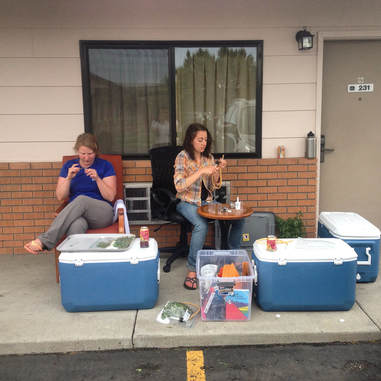I am interested in understanding how biological interactions within a community influence ecosystem functions such as pest suppression. I use a mix of field and laboratory approaches, and I particularly enjoy collaborating with a diverse group of scientists and farmers to make research more broadly applicable. I think science is fun and exciting, and I am passionate about solving problems that help farmers to manage their land sustainably and profitably.
Ecological pest management in alfalfa

Zoe and Alanna prepare parasitism assays after a day of field sampling.
I study both the biological and social dimensions of pest management and have focused my research in Wyoming on the alfalfa weevil, the most problematic pest in Western United States alfalfa. My work, in collaboration with sociologist Dr. Shiri Noy, has described producer perceptions and priorities of alfalfa pest management (Jabbour & Noy 2017) and producer social networks (Noy & Jabbour 2017). My MS student Makenzie Pellissier’s thesis research evaluated whether annual or perennial flower strips could impact biological pest control of alfalfa weevil (Pellissier & Jabbour 2018) and we have sampled producer fields throughout southeastern Wyoming to better understand factors that impact weevil parasitism, in collaboration with Dr. Tatyana Rand of USDA-ARS and others (Rand et al. 2018, Pellissier et al. in prep). Our newly funded project will examine the interaction between harvest timing and biological control, with the overarching goal of making early harvest a more effective weevil management strategy for producers.
Role of plant diversity in cropping systems
I have long been fascinated by the role of plant diversity, both across space and time, in cropping systems. Recent and current projects in the lab include: measuring the impact of interseeding cover crops into standing field corn, testing how different types of flower strip habitats affect parasitoid communities, and how weed management of invasive toadflax affects pollinator communities.
Mental models of organic weed management
As a post-doc in Maine with Eric Gallandt, I joined a project focused on describing the "mental models" of both organic farmers and scientists on the topic of weed management. This work completely fascinated me and propelled me to integrate social and biological dimensions in my future work on pest management in alfalfa (above). We defined mental models as a network of knowledge, beliefs, and perceptions that inform decision-making. Our research showed that farmer and scientist mental models on this topic are often in agreement, but the discrepancies highlight areas to improve or target future communications (Jabbour et al. 2013). I also found that mental models of organic farmers were associated with on-farm biological indicators - for example, how risky a farmer thinks weeds are is correlated with weed abundance on their farm (Jabbour et al. 2014).
Ecology of insect pathogens
Soil-dwelling insect pathogenic nematodes and fungi occur worldwide, and can contribute to arthropod mortality in both natural and applied systems. Their survival and efficacy is highly variable. Although none of my current research involves insect pathogens, I have spent many years working in these fascinating systems. In graduate school, I designed an experiment to test for effects of crop and refuge habitats on the survival and dispersal of pathogenic nematode Steinernema carpocapsae (Jabbour and Barbercheck 2008), and in turn, the response of soil arthropods to the introduction of these nematodes (Jabbour and Barbercheck 2011). Pathogenic nematodes could be a food source as well as a mortality factor for arthropods, thus potentially playing a defining role in soil food webs. I also studied the effects of management strategies on entomopathogenic fungi (Jabbour and Barbercheck 2009).
As a post-doc in Washington, I expanded my focus to test for effects of pathogen diversity on insect host mortality. Working with undergraduate Elizabeth Aultman, and collaborators Dave Crowder and Bill Snyder, we found that diverse communities of insect pathogens cause higher mortality levels of Colorado potato beetles than single species of pathogens (Jabbour et al. 2011). This finding has implications for managers applying insect pathogens as a biopesticide.
As a post-doc in Washington, I expanded my focus to test for effects of pathogen diversity on insect host mortality. Working with undergraduate Elizabeth Aultman, and collaborators Dave Crowder and Bill Snyder, we found that diverse communities of insect pathogens cause higher mortality levels of Colorado potato beetles than single species of pathogens (Jabbour et al. 2011). This finding has implications for managers applying insect pathogens as a biopesticide.
